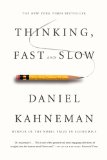Summary | Excerpt | Reviews | Beyond the Book | Readalikes | Genres & Themes | Author Bio

Critics' Opinion:
Readers' Opinion:
First Published:
Oct 2011, 512 pages
Paperback:
Apr 2013, 512 pages
 Book Reviewed by:
Book Reviewed by:
Beverly Melven
Buy This Book
Chapter 1
The Characters of the Story
To observe your mind in automatic mode, glance at the image below.

Figure 1
Your experience as you look at the woman's face seamlessly combines what we normally call seeing and intuitive thinking. As surely and quickly as you saw that the young woman's hair is dark, you knew she is angry. Furthermore, what you saw extended into the future. You sensed that this woman is about to say some very unkind words, probably in a loud and strident voice. A premonition of what she was going to do next came to mind automatically and effortlessly. You did not intend to assess her mood or to anticipate what she might do, and your reaction to the picture did not have the feel of something you did. It just happened to you. It was an instance of fast thinking.
Now look at the following problem:
17 × 24
You knew immediately that this is a multiplication problem, and probably knew that you could solve it, with paper and pencil, if not without. You also had some vague intuitive knowledge of the range of possible results. You would be quick to recognize that both 12,609 and 123 are implausible. Without spending some time on the problem, however, you would not be certain that the answer is not 568. A precise solution did not come to mind, and you felt that you could choose whether or not to engage in the computation. If you have not done so yet, you should attempt the multiplication problem now, completing at least part of it.
You experienced slow thinking as you proceeded through a sequence of steps. You first retrieved from memory the cognitive program for multiplication that you learned in school, then you implemented it. Carrying out the computation was a strain. You felt the burden of holding much material in memory, as you needed to keep track of where you were and of where you were going, while holding on to the intermediate result. The process was mental work: deliberate, effortful, and orderly - a prototype of slow thinking. The computation was not only an event in your mind; your body was also involved. Your muscles tensed up, your blood pressure rose, and your heart rate increased. Someone looking closely at your eyes while you tackled this problem would have seen your pupils dilate. Your pupils contracted back to normal size as soon as you ended your work - when you found the answer (which is 408, by the way) or when you gave up.
Two Systems
Psychologists have been intensely interested for several decades in the two modes of thinking evoked by the picture of the angry woman and by the multiplication problem, and have offered many labels for them. I adopt terms originally proposed by the psychologists Keith Stanovich and Richard West, and will refer to two systems in the mind, System 1 and System 2.
When we think of ourselves, we identify with System 2, the conscious, reasoning self that has beliefs, makes choices, and decides what to think about and what to do. Although System 2 believes itself to be where the action is, the automatic System 1 is the hero of the book. I describe System 1 as effortlessly originating impressions and feelings that are the main sources of the explicit beliefs and deliberate choices of System 2. The automatic operations of System 1 generate surprisingly complex patterns of ideas, but only the slower System 2 can construct thoughts in an orderly series of steps. I also describe circumstances in which System 2 takes over, overruling the freewheeling impulses and associations of System 1. You will be invited to think of the two systems as agents with their individual abilities, limitations, and functions.
Thinking, Fast and Slow Copyright © 2011 by Daniel Kahneman





The Funeral Cryer by Wenyan Lu
Debut novelist Wenyan Lu brings us this witty yet profound story about one woman's midlife reawakening in contemporary rural China.
Your guide toexceptional books
BookBrowse seeks out and recommends the best in contemporary fiction and nonfiction—books that not only engage and entertain but also deepen our understanding of ourselves and the world around us.